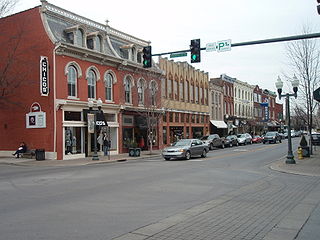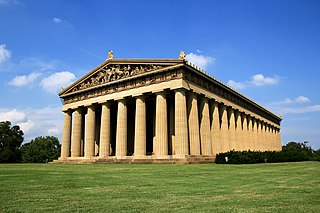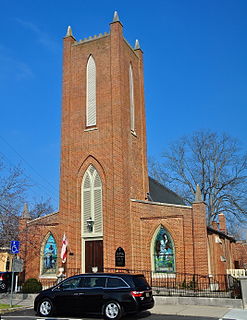Knights of Pythias Pavilion | |
Knights of Pythias Pavilion, March 2014. | |
| Location | TN 96, Franklin, Tennessee |
|---|---|
| Coordinates | 35°55′57″N86°54′30″W / 35.93250°N 86.90833°W Coordinates: 35°55′57″N86°54′30″W / 35.93250°N 86.90833°W |
| Area | 3.7 acres (1.5 ha) |
| Built | 1897 |
| Architect | Gibel,Henry |
| Architectural style | Classical Revival |
| MPS | Williamson County MRA [1] |
| NRHP reference # | 88000292 [2] |
| Added to NRHP | April 14, 1988 |
The Knights of Pythias Pavilion in Franklin, Tennessee, also known as Carlisle House, is a Classical Revival architecture building designed by Henry Gibel and built in 1897. It was listed on the National Register of Historic Places in 1988. [2]

Franklin is a city in, and the county seat of, Williamson County, Tennessee, United States. About 21 miles (34 km) south of Nashville, it is one of the principal cities of the Nashville metropolitan area and Middle Tennessee. As of 2017, its estimated population was 78,321, and it is the seventh-largest city in Tennessee.
Henry Gibel was a Swiss-born American architect. He designed many buildings in Tennessee, some of which are listed on the National Register of Historic Places.

The National Register of Historic Places (NRHP) is the United States federal government's official list of districts, sites, buildings, structures, and objects deemed worthy of preservation for their historical significance. A property listed in the National Register, or located within a National Register Historic District, may qualify for tax incentives derived from the total value of expenses incurred preserving the property.
According to a 1988 study of Williamson County historical resources, conducted by staff of the Tennessee Historical Commission:
The Tennessee Historical Commission (THC) is the State Historic Preservation Office for the U.S. state of Tennessee. Headquartered in Nashville, it is an independent state agency, administratively attached to the Department of Environment and Conservation. Its mission is to protect, preserve, interpret, maintain, and administer historic places; to encourage the inclusive diverse study of Tennessee's history for the benefit of future generations; to mark important locations, persons, and events in Tennessee history; to assist in worthy publication projects; to review, comment on and identify projects that will potentially impact historic properties; to locate, identify, record, and nominate to the National Register of Historic Places all properties which meet National Register criteria, and to implement other programs of the National Historic Preservation Act of 1966 as amended. The Tennessee Historical Commission also refers to the entity consisting of 24 Governor-appointed members and five ex officio members.
An unusual addition to the county's architecture in the 1890s was the Knights of Pythias Pavilion which was moved to a hill west of Franklin (WM-996). The pavilion was originally located on the grounds of the Tennessee Centennial Exposition in Nashville which was held in 1897. It was purchased after the exposition and moved by wagon to its present location off Highway 96. The building is of Neo-Classical design and features a prominent red dome. (page 31) [1]
Later the same study describes again:
One of the most significant frame residences in the county is the Knights of Pythias Pavilion (WM-996) which was originally constructed in Nashville for the 1897 Centennial Exposition. The pavilion was part of the Centennial complex and after the Exposition came to an end it was purchased and moved to Williamson County. The house has Colonial Revival detailing and a prominent central projecting dome. The house has not been altered and is one of the most unusual designs in the county. (page 43)















